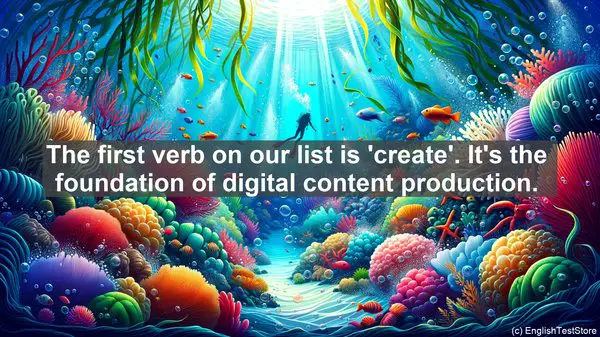Introduction
Welcome to today’s lesson. In the world of digital content creation and multimedia production, having a strong vocabulary is essential. It not only helps in effective communication but also showcases your expertise. Today, I’ll be sharing with you the top 10 verbs that are frequently used in this field. So, let’s get started!
1. Create
The first verb on our list is ‘create’. It’s the foundation of digital content production. Whether it’s a lesson, an image, or a piece of written content, everything starts with creation. It’s the process of bringing an idea to life using various tools and techniques.
2. Edit
Next up, we have ‘edit’. Once the initial content is created, it often requires refinement. That’s where editing comes in. It involves making changes, adding or removing elements, and ensuring the final product is polished and coherent.
3. Design
Designing is a crucial aspect of multimedia production. It’s not just about aesthetics but also about functionality. Whether it’s a website, an app, or a graphic, design plays a significant role in user experience and engagement.

4. Produce
After the creation and editing stages, it’s time for production. This involves the actual execution of the project, be it rendering a lesson, printing a document, or publishing an article. It’s the step where the content becomes ready for distribution.
5. Collaborate
In today’s digital landscape, collaboration is key. Many projects require a team effort, with individuals bringing their expertise together. Collaborating involves effective communication, task delegation, and ensuring everyone is on the same page.
6. Optimize
Once the content is created and published, the work doesn’t end there. Optimization is crucial for maximizing its reach and impact. It can involve anything from SEO techniques for a blog post to compression methods for a lesson.
7. Analyze
In the digital realm, data is abundant. Analyzing this data is essential for understanding the performance of your content. It can involve metrics like views, engagement, or even user feedback. This analysis helps in making informed decisions for future projects.
8. Promote
Promotion is a vital step in content creation. After all, what good is great content if it doesn’t reach the intended audience? Promoting involves various strategies, from social media marketing to email campaigns, with the goal of increasing visibility and engagement.
9. Engage
Engagement is more than just views or likes. It’s about creating a connection with your audience. This can be through interactive elements in a lesson, a comment section on a blog, or even live Q&A sessions. Engaging content keeps the audience coming back for more.
10. Evolve
The digital landscape is ever-changing. What works today may not work tomorrow. That’s why it’s crucial to constantly evolve and adapt. This can involve staying updated with the latest trends, learning new tools, or even experimenting with different content formats.

